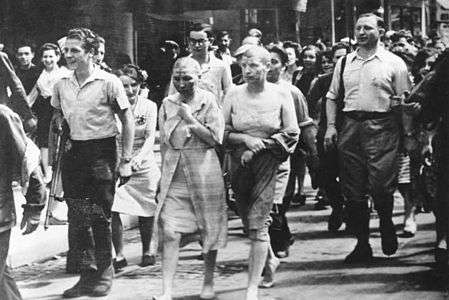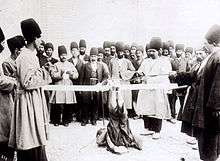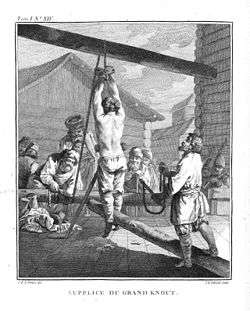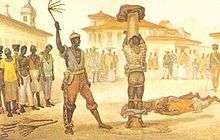Public humiliation

Public humiliation is the dishonoring showcase of a person, usually an offender or a prisoner, especially in a public place. It was regularly used as a form of punishment in former times, and is still practiced by different means in the modern era.
In the United States it was common in the 19th century and fell out of common use in the 20th century, though it has seen a revival starting in the 1990s.[1]
Shameful exposure





Public humiliation could take a number of forms. Most often a criminal was placed in the center of town and having the local populace enact a form of "mob justice" on the individual. The punishment of public humiliation could be, amongst other things, an offender being forced to relate his crime, such as by exaggerated physical parody: a 'shame flute' for a bad musician or wearing a giant rosary (Dutch: schandstenen, "stones of shame") for someone late to church. The offender could alternatively be sentenced to remain exposed in a specific public place, in a restraining device. Public shame shows how the nature of man changes throughout time and the reason for many of the problems we see today in our society and culture
In the Low Countries, the schandstoel ("Chair of shame"), the kaak or schandpaal ("pole of shame", a simple type of pillory), the draaikooi were customary for adulteresses, and the schopstoel, a scaffolding from which one is kicked off to land in mud and dirt.
In the more extreme cases being subjected to verbal and physical abuse from the crowd, which could have serious consequences especially when the hands are not free to protect himself. Some sentences actually prescribe additional humiliation, such as shaving, or combine it with painful corporal punishments, see below.[2]
In Colonial America, common forms of public humiliation were the stocks and pillory, imported from Europe. Nearly every sizable town had such instruments of public humiliation, usually at the town square. Historic public humiliation displays can still be seen in the historic Virginia town of Colonial Williamsburg.
In pre–World War Japan, adulterers were publicly exposed purely to shame them.
In post-Colonial times, judicial use of public humiliation punishment has largely fallen out of favor since the practice is now considered cruel and unusual punishment, which is outlawed in the United States Constitution.[3]:501
In Siam, an adulteress was paraded with a hibiscus behind the ear. Thieves were tattooed on the face. Other criminals were paraded with a device made of woven cane on the forehead, or lengths of bamboo hung around the neck. Errant Brahmans had to wear a string of oversize beads.
Just like painful forms of corporal punishment, it has parallels in educational and other rather private punishments (but with some audience), in school or domestic disciplinary context, and as a rite of passage. Physical forms include being forced to wear some sign such as "donkey ears" (simulated in paper, as a sign one is—or at least behaved—proverbially stupid), wearing a dunce cap, having to stand, kneel or bend over in a corner, or repeatedly write something on a blackboard ("I will not spread rumors", for example). Here different levels of physical discomfort can be added, such as having to hold heavy objects, go barefoot (see below) or kneel on an uneven surface. Like physical punishment and harsh hazing, these have become controversial in most modern societies, in many cases leading to legal restrictions and/or (sometimes voluntary) abolishment.
Having the head shaved can be a humiliating punishment prescribed in law,[4] but also something done as "mob justice" - a stark example of which was the thousands of European women who had their heads shaved in front of cheering crowds in the wake of World War II,[5][6] as punishment for associating with occupying Nazis during the war.
Forcing people to go barefoot has been used as a relatively effortless and more subtle form of humiliation in most past and present civilized cultures, primarily using the visual contrast to the standard form of appearance while also creating some level of physical discomfort. The exposure of bare feet often served as an indicator for imprisonment and slavery throughout ancient as well as modern history.[7] Even today prisoners officially have to go barefoot in many countries of the world and are also presented in court and showcased to the public unshod.[8][9][10][11][12][13][14] As shoes are commonly worn by all social classes since antiquity in most civilized societies, showcasing a captive to the public in bare feet traditionally symbolizes the person's loss of social standing and personal autonomy. It usually also causes a considerable degree of humiliation, as this noticeable detail typically sets the prisoner apart from spectators visually and demonstrates the person's vulnerability and general powerlessness.
Further means of public humiliation and degradation consist in forcing people to wear typifying clothes, which can be penitential garbs or prison uniforms.
Presenting arrestees or prisoners to the public in restraints (such as handcuffs, shackles or similar devices) also serves as a convenient method of public humiliation besides the primal security aspects. The effect is complemented by presenting the person in a prison uniform or similar clothing.
Corporal punishment



Apart from specific methods essentially aiming at humiliation, several methods combine pain and humiliation or even death and humiliation. In some cases, pain or at least discomfort is insignificant or rather secondary to the humiliation.
Public punishment
The simplest is to administer painful corporal punishment in public - the major aim may be deterrence of potential offenders - so the public will witness the perpetrator's fear and agony. This can either take place in a town square or other public gathering location such as a school, or take the form of a procession through the streets. This was not uncommon in the sentences to Staupenschlag (whipping or birching, generally on the bare buttocks) in various German-speaking states, till the 19th century. A naval equivalent was Flogging round the fleet on a raft taken from ship to ship for consecutive installments of a great total of lashes, that could even be lethal. In some countries the punishment of foot whipping is executed in public to this day.
- The humiliation as well as degradation is generally intensified if the perpetrator is unclothed (partially or entirely) as the exposure leaves the person feeling vulnerable and helpless. A common and simple form of humiliating exposure consists in taking away a person's shoes and keeping him or her barefoot during corporal punishment or generally.
- Further means of intensifying the public humiliation and degradation especially during punishment consist in forcing people to wear typifying clothes, which can be prison uniforms or in former times penitential garbs or rags, further incremented in combination with an exposure aspect such as bare feet.
- Even when not strictly public, humiliation can still be a psychologically "painful" aspect of punishment because of the presence of witnessing peers (such as fellow prisoners), staff or other onlookers, or simply because the person administering the punishment is witnessing the reactions of the culprit. The loss of self-control in the presence of bystanders further increments the humiliating effect of the punishment significantly. This is also true for punishments in class and similar situations.
- Crucifixion was used by the Romans to add public humiliation to a death penalty. Josephus describes how the Roman soldiers would crucify people naked, and using different tortuous positions as a way to further humiliate them. Crucified bodies were left to decay on the cross for weeks, and crows would come to feed on the corpses; this can be seen as post-mortem public humiliation. See also gibbeting.
Torture marks
%2C_The_Bostonians_Paying_the_Excise-man%2C_or_Tarring_and_Feathering_(1774)_-_02.jpg)
The humiliation can be extended; intentionally or not; by leaving visible marks, such as scars, notably on body parts that are normally left visible. This also serves as a virtually indelible criminal record. This can even be the main intention of the punishment, as in the case of scarifications, such as branding. It invariably is essential in forms of mutilation, such as ear cropping, though the functional loss is even greater; pain may even be intentionally minimized as in the case of surgical amputation, eliminating the risk of accidental death. Tarring and feathering also serves as means of extended humiliation.
Psychological effects
Public shaming can result in negative psychological effects and devastating consequences, regardless of the punishment being justifiable or not. It could cause depression, suicidal thoughts and other severe mental problems. The humiliated individuals may develop a variety of symptoms including apathy, paranoia, anxiety, PTSD, etc. The rage and fury may arise in the persecuted individual, themselves lashing out against innocent victims, as they seek revenge or as a means of release.
See also
References
| Wikimedia Commons has media related to Public humiliation. |
- ↑ http://articles.chicagotribune.com/2000-04-12/news/0004120235_1_unusual-punishment-humiliation-sentencing
- ↑ Cox, James (Spring 2009). "Bilboes, Brands, and Branks: Colonial Crimes and Punishments". Colonial Williamsburg Journal.
- ↑ Ziel, Paul (2005). "Eighteenth Century Public Humiliation Penalties in Twenty-First Century America: The 'Shameful' Return of 'Scarlet Letter' Punishments in U.S. v. Gementera" (PDF). BYU Journal of Public Law. 19 (2): 499–522.
- ↑ "Article 87 ... shall be sentenced to flogging, having his head shaven, and one year of exile...", The Islamic Penal Code of the Islamic Republic of Iran
- ↑ Antony Beevor. "''"An Ugly Carnival"'', The". The Guardian. Retrieved 2014-07-13.
- ↑ "Shorn Women: Gender and Punishment in Liberation France", ISBN 978-1-85973-584-8
- ↑ "Cape Town and Surrounds.". westerncape.gov.za. Retrieved July 18, 2012.
- ↑ "Australian addict welcomes 31-year prison term". smh.com.au.
- ↑ "Irish Australian man facing jail in Thailand - Irish Echo". irishecho.com.au.
- ↑ "A Foreigner in a Thai Court". Thai Prison Life - ชีวิตในเรือนจำ.
- ↑ "B.C. pedophile, homeward bound after Thai prison term, arrested at Vancouver airport". The Globe and Mail.
- ↑ Kocha Olarn, CNN (23 January 2013). "Thai court sentences activist to 10 years in prison for insulting king - CNN.com". CNN.
- ↑ "theage.com.au - The Age". theage.com.au.
- ↑ "Extradition hearing for arms dealer postponed". taipeitimes.com.
Further reading
- So You've Been Publicly Shamed, a 2015 book by Jon Ronson on the modern phenomenon of public shaming on Twitter and elsewhere on social media.